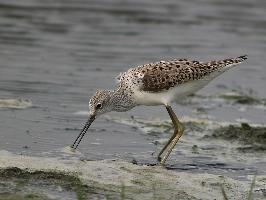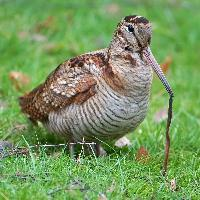
Descrierea animalului
The Common Greenshank (Tringa nebularia) is a captivating wader, belonging to the large family of birds known as Scolopacidae. This species is distinguished by its elegant stature, long legs, and a distinctive upturned bill, features that make it a sight to behold in its natural habitats. Typically, the Common Greenshank measures about 30-34 cm in length, with a wingspan ranging from 61 to 67 cm, making it a medium-sized member of its family.One of the most striking features of the Common Greenshank is its plumage. During the breeding season, adults display a beautiful mottled gray and white pattern across their back and wings, with darker, more defined spots and streaks adorning their breast and neck. In contrast, their winter plumage is more subdued, showcasing a sleek, grayish-white body that still retains a graceful appeal. Juveniles resemble the winter adults but have a more pronounced scaly pattern on their wings and back.
The bill of the Common Greenshank is another notable characteristic, long and slender with a slight upward curve, adeptly designed for foraging in mudflats and shallow waters. Their legs are long and typically a greenish-gray color, which is thought to be the origin of their common name. These long legs not only elevate them above the cold waters but also allow them to navigate through mudflats and marshes with ease, in search of prey.
Common Greenshanks are versatile feeders, their diet mainly consisting of small invertebrates, including insects, crustaceans, and mollusks, which they skillfully pick from the mud or water's surface. Occasionally, they might also consume small fish and amphibians, showcasing their adaptability in foraging.
Found across a broad range, the Common Greenshank breeds in the taiga and tundra of northern Eurasia, from Scandinavia eastward to Siberia. Come winter, these birds undertake a lengthy migration to warmer climates, with many heading to Africa, southern Asia, and Australia. This migration is a testament to their endurance and the global interconnectedness of bird migration patterns.
Behaviorally, Common Greenshanks are known for their wariness, often alert to any potential threats. They emit a sharp, piercing call when alarmed, which serves as a signal to other birds in the vicinity. During the breeding season, they are solitary or form loose colonies, nesting on the ground in well-concealed locations, where they lay a clutch of usually four eggs.
The habitats of the Common Greenshank are as diverse as their diet, ranging from freshwater lakes and marshes to coastal mudflats and estuaries. This adaptability in habitat preference underscores their resilience and the importance of preserving diverse aquatic ecosystems for their survival.
Despite facing threats from habitat loss and degradation, particularly in their migratory and wintering grounds, the Common Greenshank remains classified as Least Concern by the International Union for Conservation of Nature (IUCN). This status, however, should not lead to complacency, as continued conservation efforts are crucial to ensure that these elegant birds remain a common sight in their natural habitats.
In summary, the Common Greenshank is a remarkable bird, embodying the beauty and resilience of the avian world. Its presence enriches the ecosystems it inhabits, and its migration patterns highlight the interconnectedness of our global environment. As such, the Common Greenshank stands as a symbol of the natural wonders that demand our respect, appreciation, and protection.
Animale similare
Fotografii noi cu animale
Top 10 animale
- Dolphin gull (Leucophaeus scoresbii)
- Diana monkey (Cercopithecus diana)
- Moustached guenon (Cercopithecus cephus)
- Greek tortoise (Testudo graeca)
- Stone loach (Barbatula barbatula)
- Galápagos tortoise (Geochelone nigra complex)
- Japanese macaque (Macaca fuscata)
- Russian tortoise (Testudo horsfieldii)
- Common flying dragon (Draco volans)
- Galápagos penguin (Spheniscus mendiculus)


